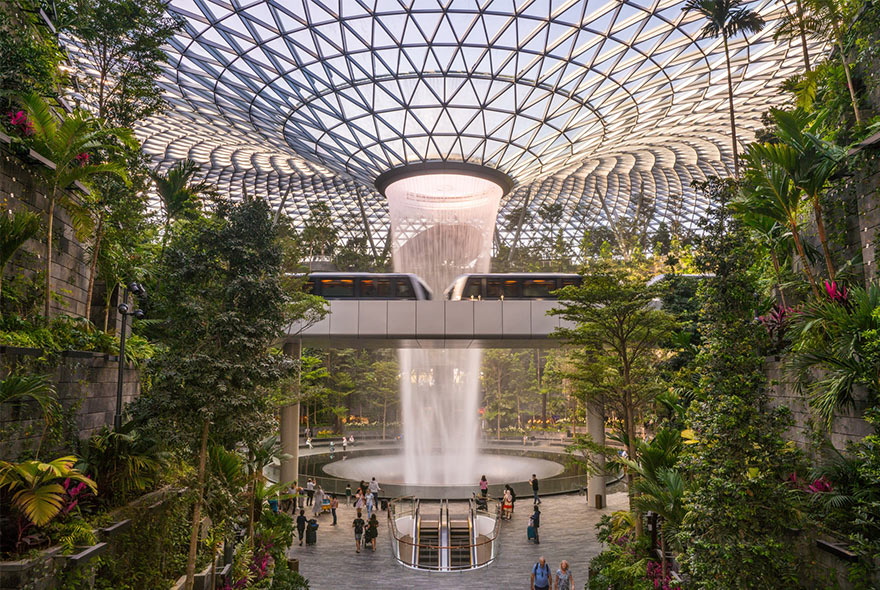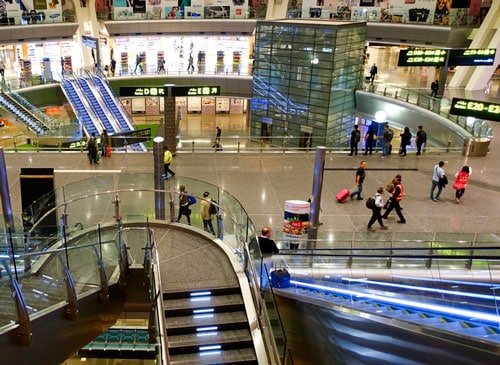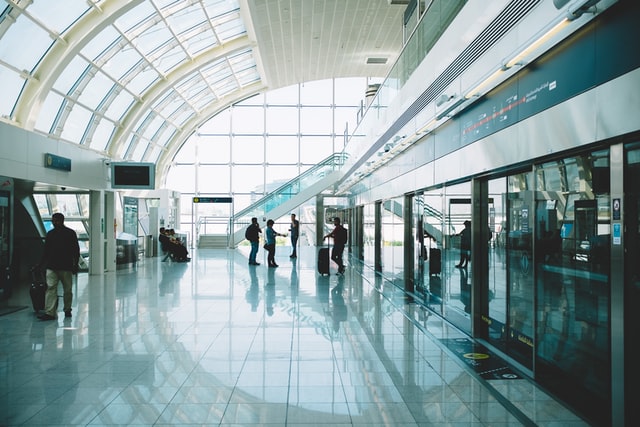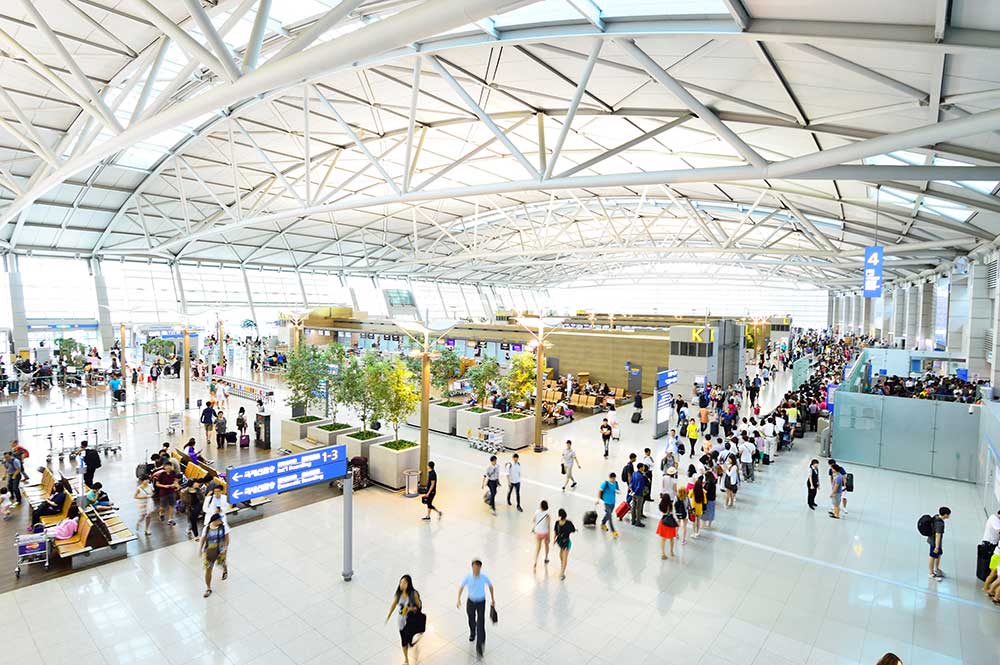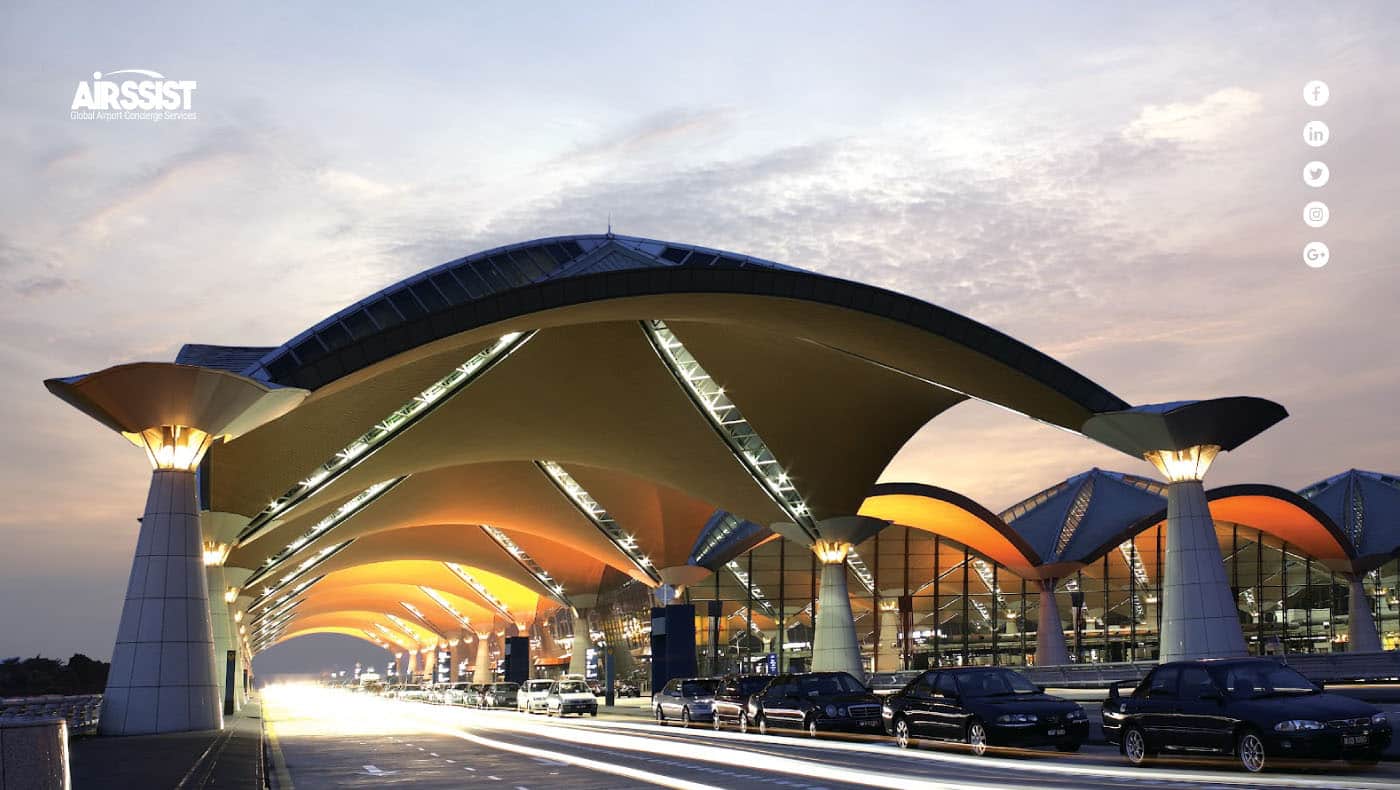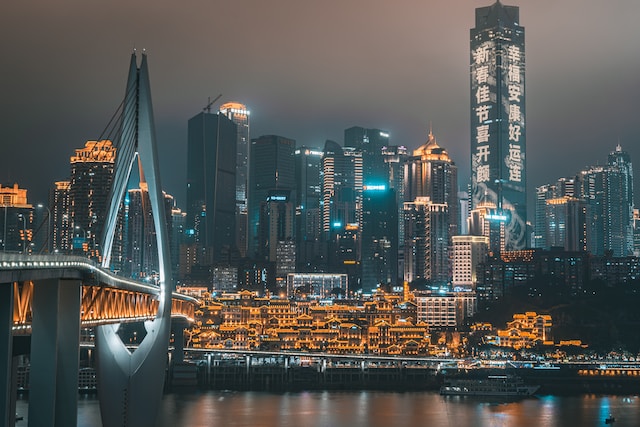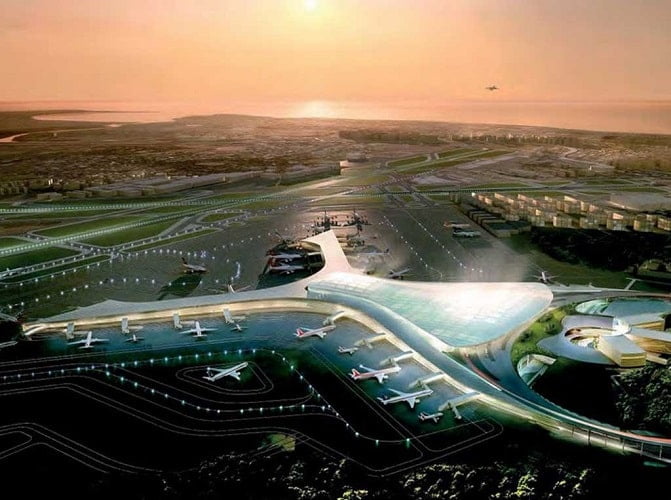Table of Contents
Airports are more than just transit hubs; they’re architectural marvels, cultural showcases, and luxurious sanctuaries. Here, we explore the most amazing airports worldwide, renowned for their beauty, innovation, and traveler-friendly features.
1. Singapore Changi Airport (SIN) – Singapore
The Changi International Airport in Changi, Singapore, serves as a major hub for international flights. In addition, it is one of the busiest airports in the world, The airport’s infrastructure, services, and overall passenger experience have earned it numerous awards and distinctions, placing it among the greatest airports in the world.
The airport in Singapore is universally regarded as the best in the world. Because it boasts multiple amenities including a butterfly garden, a rooftop pool, and a theater for which it has received accolades.
- Annual Passenger Traffic: Over 68 million (pre-pandemic, 2019).
- Awards: Skytrax “World’s Best Airport” for 8 consecutive years (2013–2020).
- Plan Your Stopover: Changi Airport Concierge Services.
2- Hamad International Airport (DOH) – Doha, Qatar
Hamad International Airport (HIA), located in Doha, the capital of Qatar, is a striking symbol of the country’s modern ambition and luxury. Replacing the former Doha International Airport in 2014, HIA has quickly risen to become one of the busiest travel hubs in the Middle East, handling over 40 million passengers annually as of 2022.
Built at a cost of $16 billion and spanning more than 5,500 acres, the airport offers far more than just runways and terminals. It’s a full-fledged travel experience designed with comfort, efficiency, and elegance in mind. From its expansive, light-filled concourses to its award-winning architecture and passenger-focused amenities, HIA blends functionality with luxury.
The airport features a dedicated terminal for first-class and business travelers, three main concourses, and a wide array of high-end dining and shopping options. Travelers can relax in state-of-the-art lounges, check into the on-site 200-room transit hotel, or recharge in the fitness center, complete with a swimming pool, gym, and spa facilities.
Art and design also play a central role—perhaps most notably with the whimsical 23-foot-tall “Lamp Bear” sculpture by Swiss artist Urs Fischer, now a quirky yet iconic fixture within the terminal. Recognized globally for its excellence, HIA was crowned the “World’s Best Airport” by Skytrax in both 2021 and 2022.
Whether you’re stopping over or starting a journey, Hamad International isn’t just an airport—it’s an experience.
Enjoy a Seamless Transit Doha Airport VIP Services.
3- Tokyo Haneda Airport (HND) – Japan
Tokyo’s Haneda Airport is a marvel of efficiency and cleanliness, serving as a gateway for over 85 million passengers annually. Its proximity to the city center makes it a top choice for business travelers. Haneda offers observation decks with panoramic views, authentic Japanese dining, and cultural exhibitions that showcase the country’s traditions and artistry.
- Annual Passenger Traffic: Over 85 million (2019).
- Awards: Ranked as the cleanest airport by Skytrax (2023).
- Travel Smoothly: Haneda Airport Concierge Service.
4- Dubai International Airport (DXB)
The city of Dubai, located in one of the seven emirates that make up the United Arab Emirates, is served primarily by Dubai International Airport. In 2019, it will serve over 86 million people, making it one of the world’s busiest airports. Al Garhoud is around 4 km southeast of Dubai’s city center, and that’s where you’ll find the airport. The airport’s three main terminals offer a variety of services and amenities to passengers. Terminals 2 and 1 serve a wide variety of airlines, including budget ones, while the world’s largest airport terminal, Terminal 3, is utilized entirely by Emirates Airlines. In a nutshell, passengers can take advantage of the airport’s many shops, restaurants, lounges, transit motels, spas, and fitness centers.
- Annual Passenger Traffic: Over 66 million (2022).
- Highlight: Dubai Duty-Free Shopping.
- Your VIP Guide: DXB Airport Services.
5- Incheon International Airport (ICN)
Seoul and its surrounding metropolitan region are served by Incheon International Airport, the largest airport in South Korea. It’s roughly 30 km west of Seoul, on an island in the Yellow Sea. With over 70 million annual travelers, this airport is among the busiest in the world. Additionally, the airport boasts an up-to-date and roomy layout, with two main passenger terminals and an auxiliary terminal for low-cost carriers. There are a variety of shops and restaurants, as well as lounges, transit hotels, a spa, a golf course, and a cultural center displaying traditional Korean arts and crafts, all available to passengers at Incheon International Airport.
- Annual Passenger Traffic: Over 70 million (2019).
- Awards: Skytrax “Best Airport Staff” 2022.
- Enhance Your Journey: Incheon Airport Concierge Services.
6- Munich Airport (MUC)
Munich Airport, located in the heart of Bavaria, Germany, is a gateway for over 47 million passengers annually. Known for its unique offerings, it boasts an onsite brewery, seasonal Christmas markets, and a visitors’ park with activities for families. Its spacious lounges and high-end shopping provide an unmatched travel experience.
- Annual Passenger Traffic: Over 47 million (2019).
- Awards: Skytrax “Best Airport in Europe” 2023.
- Tailored Experiences: Munich Airport Concierge Services.
7- Zurich Airport (ZRH)
Zurich Airport is a Swiss masterpiece of efficiency and sustainability, serving over 31 million passengers annually. It’s lauded for its seamless operations and unique amenities, including bike rentals, nature trails, and a cinema. Zurich’s breathtaking alpine views add to its charm.
- Annual Passenger Traffic: Over 31 million (2019).
- Highlight: Nature Trail and Bike Rentals.
- Your VIP Partner: Zurich Airport Concierge Services .
8- Kuala Lumpur International Airport (KUL)
Kuala Lumpur International Airport, nestled in Malaysia, is a blend of modernity and nature, serving over 52 million passengers annually. Its futuristic design features an indoor rainforest and a unique sky bridge connecting terminals. KUL is a true embodiment of Southeast Asian hospitality.
- Annual Passenger Traffic: Over 52 million (2019).
- Highlight: Indoor Rainforest.
- Upgrade Your Trip: Kuala Lumpur Airport Meet and Greet Services.
9- Vancouver International Airport (YVR)
Vancouver International Airport in Canada is a celebration of nature and culture, serving over 25 million passengers annually. It showcases stunning indigenous art, a vibrant aquarium, and eco-friendly initiatives that prioritize sustainability. YVR’s focus on passenger comfort and design makes it a favorite in North America.
- Annual Passenger Traffic: Over 25 million (2019).
- Awards: Skytrax “Best Airport in North America” 2023.
- Experience Luxury: Vancouver Airport Concierge.
10- Istanbul Airport (IST)
Istanbul Airport, Turkey’s premier aviation hub, is one of the world’s largest airports, serving over 64 million passengers annually. The airport is known for its state-of-the-art terminal, luxury shopping, and diverse dining options. Its scale and efficiency are a testament to Turkey’s growing prominence as a global connector.
- Annual Passenger Traffic: Over 64 million (2022).
- Highlight: World-Class Duty-Free.
- Smooth Transits: Istanbul Airport Services.
11- Hong Kong International Airport (HKG)
Hong Kong International Airport serves as a vital hub for Asia, handling over 71 million passengers annually (pre-pandemic). It’s renowned for its IMAX theater, SkyCity complex, and an on-site golf course. The airport’s efficient services make it a key connector for travelers across the globe.
- Annual Passenger Traffic: Over 71 million (2019).
- Highlight: IMAX Theater and Golf Course.
- Plan Ahead: Hong Kong Airport VIP Services.
12- Seattle-Tacoma International Airport (SEA)
Seattle-Tacoma International Airport is a leader in sustainable aviation, welcoming over 51 million passengers annually. Its eco-friendly initiatives, paired with extensive art installations, create a unique travel experience. SEA’s commitment to green travel makes it stand out among U.S. airports.
- Annual Passenger Traffic: Over 51 million (2019).
- Highlight: Sustainability and Local Art.
- Simplify Your Journey: Seattle Airport Concierge.
13- Chhatrapati Shivaji Maharaj International Airport (BOM)
Mumbai’s Chhatrapati Shivaji Maharaj International Airport blends modern design with Indian heritage, serving over 50 million passengers annually. Known for its iconic Jaya He art program, it offers travelers a glimpse into India’s cultural richness.
- Annual Passenger Traffic: Over 50 million (2019).
- Highlight: Jaya He Public Art Program.
- Enhance Your Trip: Mumbai Airport Meet & Greet Services.
14- Oslo Gardermoen Airport (OSL)
Oslo Gardermoen Airport, Norway’s main aviation hub, serves over 28 million passengers annually. Renowned for its sustainable design and breathtaking views, OSL provides a serene and eco-friendly travel experience.
- Annual Passenger Traffic: Over 28 million (2019).
- Highlight: Carbon-Neutral Operations.
- Plan Your Journey: Oslo Airport VIP Services .
15- Madeira Airport, Portugal
Madeira Airport, once a modest outpost on a rugged Atlantic island, was never known for grandeur. Perched precariously at the edge of steep cliffs, the original runway was short and surrounded by terrain that left little room for expansion. Even a minor extension in 1977 couldn’t fully address the challenges of landing large aircraft on such limited real estate. But in 2000, engineers pulled off a remarkable feat of design and daring: they doubled the runway’s length by building it on a platform supported by 180 towering columns, some as high as 70 feet, jutting out into the sea. This ambitious project transformed part of the runway into a dramatic bridge over the ocean—earning it international recognition and awards for engineering innovation. Today, Cristiano Ronaldo Madeira International Airport (named after the island’s famous footballer) is not only safer and more accessible but also a marvel of modern infrastructure, often listed among the world’s most thrilling airports.
16- Denver International Airport, Colorado
When it comes to sheer land area, Denver International Airport (DEN) is the largest airport in the United States, sprawling across more than 33,000 acres—more than twice the size of Manhattan. The massive project, which culminated in the airport’s opening in 1995, required the excavation of approximately 110 million cubic yards of earth. This made room for an extensive underground tunnel system designed to transport baggage, a sprawling 1.5-million-square-foot main terminal (named Jeppesen Terminal), and one of the most advanced airport infrastructures in the world.
Among its record-setting features, DEN boasts the longest public-use runway in the country—Runway 16R/34L—which stretches an impressive 16,000 feet. This allows the airport to accommodate the world’s largest aircraft, including fully loaded Airbus A380s, at high-altitude conditions. It’s also home to the second-tallest air traffic control tower in the U.S., rising 327 feet above the plains.
And of course, towering near the entrance is the infamous 32-foot-tall sculpture known as “Blue Mustang”—a rearing, bright blue bronco with glowing red eyes, affectionately (and eerily) nicknamed “Blucifer” by locals. The statue has become a symbol of the airport, sparking both admiration and conspiracy theories alike.
17- Princess Juliana International Airport, Saint Martin
At Maho Beach on the Caribbean island of Saint Martin, a day at the beach comes with more than just sun and surf—it comes with the thunderous roar of jet engines overhead. Just behind the beach lies Princess Juliana International Airport, where arriving aircraft make their final descent directly over sunbathers’ heads, gliding low above the sand before touching down on Runway 10, which begins mere feet from the shoreline.
This surreal intersection of aviation and leisure has turned the beach into an iconic destination—not just for travelers, but for thrill-seekers and aviation enthusiasts from around the world. Watching a massive jet barrel toward you from the horizon, growing louder and larger until it seems to blot out the sky, is an electrifying experience. Some visitors hold onto the fence behind the beach, bracing against the jet blast as planes depart, while others simply lie back in the sand and marvel at the spectacle.
18- Beijing International Airport, China
Beijing Capital International Airport’s Terminal 3 isn’t just one of the largest airport terminals in the world—it’s one of the longest buildings ever constructed, stretching more than two miles end-to-end. Opened in 2008 (not 2003) ahead of the Beijing Summer Olympics, this architectural marvel spans a staggering 14 million square feet, making it one of the most expansive and visually iconic airport terminals globally.
Designed by the renowned architectural firm Foster + Partners in collaboration with ARUP, the terminal was created to resemble a dragon in flight—a powerful symbol in Chinese culture representing strength, prosperity, and good fortune. The structure’s sweeping curves and dynamic form are paired with an intentional use of traditional Chinese colors. Inside, red and gold dominate, while the exterior transitions in hue from deep orange to shimmering gold as it stretches from north to south, mirroring the natural colors of a Chinese sunset.
Terminal 3 is also a triumph of sustainable design. Its high-tech roof system is embedded with skylights and uses carefully angled panels to channel natural light throughout the interior, reducing the need for artificial lighting during daylight hours. The roof’s form also facilitates natural ventilation and helps moderate indoor temperatures. From above, parts of the terminal’s roof feature green gardens, adding both a natural element and a visual treat for passengers looking out from aircraft.
The terminal itself is divided into three sections: T3-C for domestic flights, T3-E for international departures, and T3-D as a satellite terminal used during peak times. It’s equipped with advanced passenger-processing systems and can handle over 40 million passengers annually—though in peak years, it has exceeded even that.
Whether admired from the tarmac or explored from within, Terminal 3 isn’t just an airport hub—it’s a bold architectural statement and a celebration of modern China’s global presence.
19- King Abdulaziz Airport, Saudi Arabia
Located near the holy city of Mecca, King Abdulaziz International Airport in Jeddah serves as the primary gateway for millions of Muslim pilgrims traveling to perform Hajj and Umrah. Its Hajj Terminal, in particular, is renowned not only for its size and function but also for its iconic and award-winning design.
Engineered by Horst Berger, a pioneer in tensile architecture, the terminal features a massive tent-like roof structure made from Teflon-coated fiberglass fabric. Spanning over 100 acres, this innovative design is both functional and symbolic—evoking the traditional Bedouin tents of the Arabian desert while accommodating the unique environmental and logistical needs of large-scale pilgrimages.
The terminal blends indoor and outdoor elements in a way that prioritizes both comfort and cultural relevance. The open-air design, combined with strategically placed air-conditioned areas, allows natural ventilation to flow freely beneath the canopy. This approach minimizes energy consumption while shielding travelers from the region’s intense heat and harsh sunlight.
Each of the 210 tent structures that make up the terminal works like a natural chimney, drawing hot air upward and out, while reflecting sunlight to maintain a cooler environment below. At peak capacity, the terminal can accommodate over 80,000 passengers at once—most of them pilgrims making their spiritual journey to Mecca just 70 kilometers away.
Awarded multiple architectural and engineering honors, including from the Aga Khan Award for Architecture, the Hajj Terminal is a striking example of sustainable design tailored to cultural significance and human experience. It’s not just a transit point—it’s a space thoughtfully crafted to support one of the world’s largest religious gatherings.
20- Barajas International Airport, Spain
Madrid-Barajas Airport, now known as Adolfo Suárez Madrid–Barajas Airport, has been a key hub for European and international air travel since it first opened in 1927. Over the decades, it has grown into one of Europe’s busiest and most important airports. However, it was the unveiling of Terminal 4 in 2006 that marked a dramatic transformation in both scale and design, propelling the airport into a new era of architectural innovation.
Designed by the acclaimed architecture firms Rogers Stirk Harbour + Partners and Estudio Lamela, Terminal 4 is a bold, modernist reimagining of airport space—crafted with a focus on light, openness, and fluid movement. The terminal spans over 8 million square feet and features a striking wave-like roof composed of rhythmic, undulating bamboo panels supported by brightly colored steel pillars. The color-coded columns not only aid navigation but also add a playful and artistic touch to the space.
One of Terminal 4’s most defining features is its use of natural light. A series of skylights and domes embedded in the ceiling allow daylight to pour into the terminal, creating a serene, airy atmosphere that contrasts sharply with the often-claustrophobic feel of traditional airport design. The glass-paneled walls and gently sloping ceilings contribute to this openness, blurring the line between interior and exterior spaces and providing expansive views of the surrounding airfield.
Beyond its architectural beauty, Terminal 4 was also built with efficiency in mind. It has significantly improved the airport’s passenger flow and capacity, helping Madrid-Barajas handle over 60 million travelers annually. The terminal even includes an automated people mover to connect the main terminal with its satellite building, T4S, which handles most international flights.
Awarded the prestigious Stirling Prize for architecture in 2006, Terminal 4 is more than just a transit point—it’s a landmark in sustainable, human-centered design. It stands as a shining example of how functionality and beauty can coexist, turning an airport into an experience rather than just a necessity.
Enhancing Your Travel Experience with airssist
With air traffic increasing every day, countries worldwide are planning new airports. Because of competition, these new airport designs are spectacular. Some of these are predicted to be amongst the most amazing airports in the future. Therefore, airssist Airport Concierge Services offers personalized and customized airport services to enhance the travel experience of passengers. Whether it’s a business trip, family vacation, or solo adventure, airssist provides a wide range of services designed to help travelers navigate through the airport with ease and comfort. From Meet And Greet services, fast-track security clearance, lounge access, and baggage handling, to transportation arrangements and travel assistance.
To keep yourself updated about the world of airports, keep following us. airssist keeps you informed about all the new happenings in the aviation world.
Note: Please note that the information on this page is generic & subject to change due to fluctuations in airport services. Kindly confirm service availability with our team, as offerings may vary daily.
 French | Français
French | Français Spanish | Espana
Spanish | Espana German | Deutch
German | Deutch Arabic | العربية
Arabic | العربية Chinese | 中文(简体)
Chinese | 中文(简体) Japanese | 日本語
Japanese | 日本語

